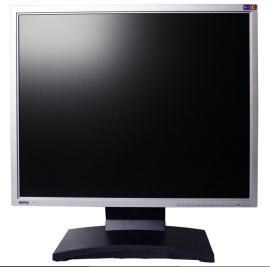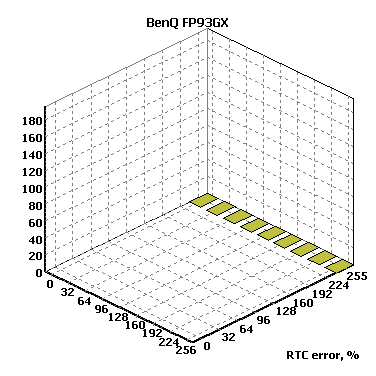LCD MONITOR REVIEW BENQ FP93GX 19 INCH
![]()
|
|
 |
||||||||||||
| Posted:2006-07-08 By lcd monitor Number of View:24764 |
|||||||||||||
By :lcd monitor Posted:2006-07-08
BenQ FP93GX
Notwithstanding its rather humble exterior, the FP93GX lcd monitor from BenQ is not a low-end product. Its price is quite high in comparison with BenQ’s T905 or FP91G+, for example. Why is it so expensive then? It’s simple: the FP93GX features response time compensation technology. Moreover, the declared response time of 2 milliseconds (on gray-to-gray transitions) puts it among the fastest lcd monitors of today.
It has a simple black-and-silver case. The stand allows adjusting the tilt of the screen.
The decorative cap on the back panel conceals fasteners for a standard VESA-compatible mount. If you want to use one, remove the lcd monitor’s own stand by unfastening the screws.
The FP93GX has both analog and digital inputs, and an integrated power adapter.
The lcd monitor’s controls are placed in the bottom left corner of the case and are designed in quite an unassuming fashion, too. Plain rectangular buttons the color of the case and an indicator of power. Quick access is provided to the brightness and contrast settings:
This is a typical BenQ menu, which is user-friendly and remembers the last changed parameter. There is only one unusual option here – you can completely turn off response time compensation. The rest of the options are customary enough. I’d say this model is somewhat odd – an expensive games-oriented home lcd monitor in a very plain-looking case that would suit a low-end office model better. Gaming lcd monitors are usually designed like the above-described ASUS PW191 so that the device would surely strike the eye of a potential customer. This seems the stranger to me since BenQ has had experience developing “image-making” models – take the 17” FP72V as an example. By default, the lcd monitor has 50% contrast and 90% brightness. I achieved 100-nit brightness of white by dropping the settings to 40% contrast and 39% brightness. Color gradients are reproduced immaculately at the lcd monitor’s default settings but look striped at lower values of contrast. The stripes are not very conspicuous, though. The viewing angles are just what you can expect from a regular TN+Film matrix. That is, the vertical angle is narrow and the image appears dark when you are looking at the screen from below. Although the manufacturer declares a viewing angle of 160 degrees, this number was arrived at by relaxing the measurement conditions (they now measure the contrast ratio by its drop to 5:1 instead of 10:1; this “innovation” was introduced by many lcd monitor manufacturers to mask the striking difference in viewing angles between TN matrixes and other technologies). The vertical viewing angle would have been much smaller if measured in compliance with the standard methodology.
The gamma curves are not ideal (the red curve sags rather too much), yet I can’t say the lcd monitor has any serious problems with color reproduction. The curves are getting closer to the theoretical ones at lower contrast values, but the difference isn’t big.
The color temperature modes are set up rather sloppily. Like on many other LCD lcd monitors, white is too warm and gray tones are too cold.
The manufacturer declares a response time of 2 milliseconds, which is the averaged number for all gray-to-gray transitions. The average of my measurements is 3.5 milliseconds (I don’t count in the “zero” diagonal of the diagram and “short” transitions like 244-255 which I didn’t measure due to an unacceptably high measurement error). I don’t mean that the manufacturer lies to us. I use a rather rude measurement method with a step of 32 whereas some manufacturers are already using a step of 1 (that is, they measure transitions like 0-1, 1-2, 2-3, …, 162-163, etc). It’s possible that the lcd monitor has low response time on such transitions. However, in this and upcoming reviews I will be giving an averaged response time for lcd monitors with response time compensation because my methodology remains the same, thus allowing to compare different models correctly. By the way, the averaged response time of TN+Film matrixes without response time compensation is typically 15-20 milliseconds and this doesn’t prevent the manufacturers from declaring a response time of 8 milliseconds in the specs.
Another thing you may be interested in when it comes to a lcd monitor with response time compensation is how accurately this new technology works. The diagram above shows the value of the RTC miss in percent. The miss is 15.2% on average, with a maximum of almost 200% (that is, the pixel brightness grows up to a value three times higher than it should be). The lcd monitor isn’t that bad overall, though. The averaged value of the miss is acceptable, and the RTC error is rather small on black-to-gray transitions, which means RTC artifacts won’t be too obvious at work
Last go brightness and contrast measurements. Both these parameters are at a very good level in this lcd monitor. The contrast ratio exceeds 300:1 which is an excellent result for a TN+Film matrix. Thus, the FP93GX is a very good gaming lcd monitor. It is indeed very fast, and its RTC error is reasonably small in most cases. The inaccurate color temperature setup is a drawback of this model, but not a very serious one since it is positioned as a gaming lcd monitor. The unassuming exterior design may prove to be a bigger drawback because people usually want a pretty-looking lcd monitor for home.
we would be happy to answer for your question . if you have suggestion or comment
regarding this review our support would be glad to help just join our forum and ask u will get the best answer
to discuss check our forum section :-) RATE THIS REVIEW | |||||||||||||
![]()

7600gt review
7600gt is the middle card range.
We already benchmarked this video card and found that ...

 geforce 8800gtx and 8800gts
geforce 8800gtx and 8800gts  Xtreview software download Section
Xtreview software download Section  AMD TURION 64 X2 REVIEW
AMD TURION 64 X2 REVIEW  INTEL PENTIUM D 920 , INTEL PENTIUM D 930
INTEL PENTIUM D 920 , INTEL PENTIUM D 930  6800XT REVIEW
6800XT REVIEW  computer hardware REVIEW
computer hardware REVIEW  INTEL CONROE CORE DUO 2 REVIEW VS AMD AM2
INTEL CONROE CORE DUO 2 REVIEW VS AMD AM2  INTEL PENTIUM D 805 INTEL D805
INTEL PENTIUM D 805 INTEL D805  Free desktop wallpaper
Free desktop wallpaper  online fighting game
online fighting game  Xtreview price comparison center
Xtreview price comparison center 

- The new version of GPU-Z finally kills the belief in the miracle of Vega transformation
- The motherboard manufacturer confirms the characteristics of the processors Coffee Lake
- We are looking for copper coolers on NVIDIA Volta computing accelerators
- Unofficially about Intels plans to release 300-series chipset
- The Japanese representation of AMD offered monetary compensation to the first buyers of Ryzen Threadripper
- This year will not be released more than 45 million motherboards
- TSMC denies the presentation of charges from the antimonopoly authorities
- Radeon RX Vega 64 at frequencies 1802-1000 MHz updated the record GPUPI 1B
- AMD itself would like to believe that mobile processors Ryzen have already been released
- AMD Vega 20 will find application in accelerating computations
- Pre-orders for new iPhone start next week
- Radeon RX Vega 57, 58 and 59: the wonders of transformation
- ASML starts commercial delivery of EUV-scanners
- The older Skylake processors with a free multiplier are removed from production
- Meizu will release Android-smartphone based on Helio P40
- AMD Bristol Ridge processors are also available in American retail
- The fate of Toshiba Memory can be solved to the next environment
- duo GeForce GTX 1080 Ti in GPUPI 1B at frequencies of 2480-10320 MHz
- New Kentsfield overclocking record up to 5204 MHz
- Lenovo released Android-smartphone K8



computer news computer parts review Old Forum Downloads New Forum Login Join Articles terms Hardware blog Sitemap Get Freebies












